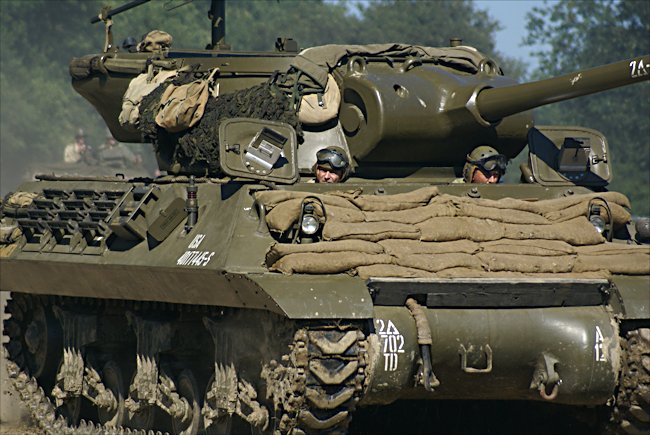Normandy Tank Museum M36 Jackson Tank Destroyer
The Normandy Tank Museum near Catz offers tank rides to visitors on restored WW2 US Army tanks. This M36 Jackson Tank Destroyer is one of the two vehicles used for tank rides. The other is a M4A4 short barreled 75mm Sherman tank. Tickets are not cheap. The Jackson TD did not arrive in Europe until September 1944. It did not land in Normandy as part of D-Day or take part in the battle for Normandy.

You can pay to go on rides on this M36 Jackson Tank Destroyer
Location
The Normandy Tank Museum is not hard to miss. It is next to the main N13 (E46) motorway. Set your Sat-Nav to the town of Catz in Normandy and then the road of La Fourchette or Rue de la Fourchette to be directed to the Museum entrance.
Specification
The M36 Jackson Tank Destroyer was powered by a Ford GAA V-8 petrol engine that produced 450 hp. It had a top road speed of 30 mph (48 km/h) and an operational range of 150 miles (240 km). It had a five man crew: commander, driver, gunner, gun-layer and loader. About 1,400 M36 Jackson TDs were built during WW2.
It was armed with a 90mm M3 Gun which was an improvement on the 76mm gun used in the Sherman tank, M10 and M18 tank destroyers. It still had problems penetrating the frontal armour of the new German King Tiger tank and the rare Jagdtiger Tank Destroyer. They could knock out Panzer IV, Panther and Tiger I tanks. For close defence it was armed with a .50cal Browning M2HB machine gun fixed to a mount on the turret. During WW2 it was open turreted like the Wolverine and Hellcat tank destroyers, but after the war a metal plate folding roof was added to provide protection from enemy grenades and shell shrapnel.
M36 Jackson 90mm Tank Destroyer’s kill Panther Tanks
On 21st December 1944 the US Army deployed M36 Jackson Tank Destroyers in the Belgium Ardennes to try and stop the German armoured offensive that would become known as the battle of the Bulge.
The Germans were trying to open up the route to Malmedy. Their advance had been spotted and radioed back to the US artillery units. A few Panther tanks emerged through the storm of exploding shells. And the cloying mud to break though the line of US foxholes where it followed the course of a long hedgerow.
Having destroyed the American 57mm and 76mm anti-tank guns using HE high explosive shells, they drove along the defensive line, raking foxhole positions with machine gun fire and wiping out positions as they went.
As the morning wore on, more panther tanks appeared. They were advancing on the Belgium Ardenne village of Dom Butgenbach without the protection of Panzer Grenadier support infantry who had been scattered in the artillery barrage.
At the critical juncture when they came in sight over the line of a ridge, some were disabled by self-propelled M10 tank destroyers of the 634th US Tank Destroyer battalion. Two more were dealt with by a couple of M4 Sherman tanks before they were in turn knocked out.
The panzers made the mistake of entering a town without the support of infantry. They were at the mercy of hand held anti-tank US bazookas. The Panthers made a break for it into open countryside. Two of the three remaining Panther tanks were disabled by the new M36 Jackson tank destroyers 90mm guns. The last one managed to escape.
D-Day 1944 books

